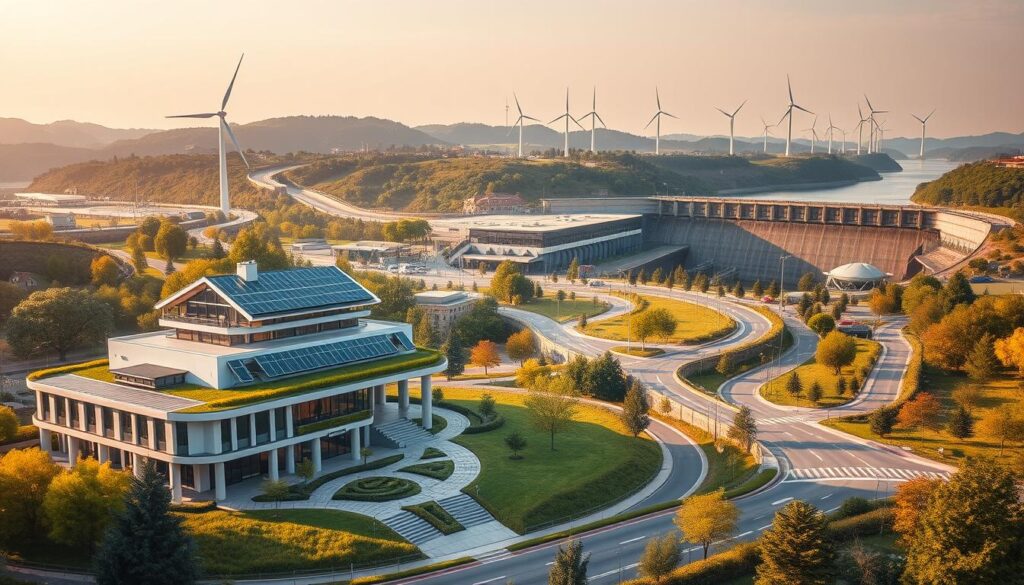The field of civil engineering is undergoing a significant transformation, driven by technological advancements and the need for sustainable infrastructure. Did you know that the global construction market is projected to reach $8 trillion by 2025? This growth is not just about the scale of projects but also about the innovative approaches being adopted to address complex societal challenges.
The intersection of civil engineering trends and social development research is crucial in shaping the future of our communities. As cities become more populated and the effects of climate change more pronounced, the need for resilient and sustainable infrastructure has never been more critical.
Key Takeaways
- The global construction market is expected to reach $8 trillion by 2025.
- Civil engineering is evolving with new technologies and methodologies.
- Sustainable infrastructure is key to addressing societal challenges.
- The intersection of civil engineering and social development is crucial.
- Innovative approaches are being adopted for resilient infrastructure.
Introduction to Civil Engineering and Social Development
As the world grapples with infrastructure challenges, civil engineering research emerges as a key driver of social development. The field of civil engineering is not just about constructing buildings and roads; it’s about creating sustainable, resilient communities that can thrive in the face of adversity.
Civil engineering research is crucial for developing innovative solutions to infrastructure challenges. By advancing emerging trends in civil engineering, researchers can improve the efficiency, sustainability, and safety of infrastructure projects. For instance, the use of new materials and technologies can significantly enhance the durability and environmental friendliness of construction projects.
Importance of Research in Civil Engineering
Research in civil engineering is vital for addressing the complex challenges faced by modern societies. It enables the development of innovative solutions that can improve infrastructure resilience, reduce environmental impact, and enhance community well-being. By investing in civil engineering research, we can foster social development innovations that have a lasting impact on communities.
Moreover, civil engineering research contributes to achieving social development goals by providing the technical expertise needed to design and implement sustainable infrastructure projects. For example, research on sustainable design practices can help reduce the carbon footprint of construction projects, aligning with global efforts to combat climate change.
Understanding Social Development Goals
Social development goals focus on improving the quality of life for communities by addressing various social, economic, and environmental challenges. Civil engineering plays a critical role in achieving these goals by providing the infrastructure necessary for economic growth, social interaction, and environmental sustainability.
By understanding the connection between civil engineering and social development goals, professionals in the field can design projects that not only meet technical requirements but also contribute to the broader social and economic development of communities.
Current Trends in Civil Engineering

Innovative trends are currently redefining the field of civil engineering, focusing on sustainable design and intelligent infrastructure. As the world grapples with the challenges of climate change, urbanization, and infrastructure degradation, civil engineers are at the forefront of developing solutions.
The importance of adopting sustainable design practices cannot be overstated. These practices not only reduce the environmental impact of construction projects but also enhance their resilience and longevity. For instance, the use of green building materials, such as recycled plastics and sustainably sourced timber, is becoming increasingly prevalent.
Sustainable Design Practices
Sustainable design practices in civil engineering encompass a broad range of strategies aimed at minimizing environmental footprint. This includes:
- Energy-efficient designs that reduce the carbon footprint of buildings and infrastructure.
- The use of renewable energy sources, such as solar and wind power, to reduce dependence on fossil fuels.
- Incorporating green spaces into urban planning to mitigate the urban heat island effect and improve air quality.
As noted by experts, “Sustainable design is not just about reducing environmental impact; it’s also about creating infrastructure that is resilient and adaptable to future challenges.” Read more about the future of civil engineering and its challenges
| Sustainable Practice | Benefits |
|---|---|
| Green Building Materials | Reduced environmental impact, enhanced energy efficiency |
| Energy-Efficient Designs | Lower operational costs, reduced carbon footprint |
| Renewable Energy Integration | Reduced dependence on fossil fuels, lower energy costs |
Smart Infrastructure Technologies
Another significant trend in civil engineering is the adoption of smart infrastructure technologies. These technologies involve the integration of sensors, IoT devices, and data analytics to create infrastructure that is not only more efficient but also more responsive to the needs of its users.
For example, smart traffic management systems can optimize traffic flow, reducing congestion and lowering emissions. Similarly, smart water management systems can detect leaks and predict maintenance needs, reducing waste and improving service delivery.
The integration of these technologies is transforming the way we design, build, and manage infrastructure. As the field continues to evolve, it is likely that we will see even more innovative applications of sustainable design practices and smart infrastructure technologies.
“The future of civil engineering lies in its ability to adapt to changing environmental conditions and to innovate in response to societal needs.” – Expert in Civil Engineering
The Role of Technology in Civil Engineering Advancements
Technology plays a pivotal role in advancing civil engineering, with various tools and techniques enhancing the design, construction, and management of infrastructure. The integration of these technologies is not only improving the efficiency and sustainability of projects but also contributing to the overall development of communities.
Use of Artificial Intelligence in Design
Artificial intelligence (AI) is being increasingly utilized in civil engineering design to improve accuracy, reduce costs, and enhance project outcomes. AI algorithms can analyze vast amounts of data, identify patterns, and make predictions, thereby assisting engineers in making informed decisions.
Benefits of AI in Design:
- Improved design accuracy
- Enhanced predictive maintenance
- Optimized resource allocation
Benefits of 3D Printing in Construction
3D printing technology is revolutionizing the construction industry by enabling the rapid creation of complex structures with reduced material waste. This technology has the potential to significantly impact the construction sector by improving efficiency and reducing environmental impact.
| Benefits | Description |
|---|---|
| Reduced Material Waste | 3D printing uses exact amounts of material, minimizing waste. |
| Increased Speed | Structures can be printed rapidly, reducing construction time. |
| Complex Designs | Enables the creation of complex geometries not feasible with traditional methods. |
The Impact of IoT on Infrastructure Management
The Internet of Things (IoT) is transforming infrastructure management by enabling real-time monitoring and data collection. IoT devices can be used to track the condition of infrastructure, predict maintenance needs, and improve overall asset management.
The use of IoT in infrastructure management is expected to grow, driven by the need for more efficient and sustainable infrastructure solutions. As the technology continues to evolve, it is likely to play an increasingly important role in shaping the future of civil engineering.
Environmental Considerations in Civil Engineering

The integration of environmental considerations into civil engineering is revolutionizing the way we approach infrastructure development. As the world grapples with the challenges of climate change and environmental degradation, the field of civil engineering is evolving to prioritize sustainability and minimize its ecological footprint.
Focus on Renewable Energy Sources
One of the key areas where environmental considerations are making a significant impact is in the adoption of renewable energy sources. Civil engineers are now designing infrastructure that incorporates solar, wind, and hydroelectric power to reduce reliance on fossil fuels. This shift not only contributes to a cleaner environment but also enhances energy security and sustainability. For more information on innovations in civil engineering aimed at improving sustainability, visit Norwich University’s article on sustainable civil engineering.
Eco-friendly Materials and Practices
In addition to renewable energy, civil engineers are also focusing on the use of eco-friendly materials and practices in construction projects. This includes the use of recycled materials, sustainable timber, and low-carbon concrete. By adopting these materials and practices, civil engineers can significantly reduce the environmental impact of their projects, contributing to sustainable social development.
The use of eco-friendly materials not only benefits the environment but also offers long-term cost savings and improved durability. As the demand for sustainable infrastructure continues to grow, the role of civil engineers in driving environmental stewardship through innovative design and construction practices becomes increasingly important.
Community Engagement in Civil Engineering Projects
Effective community engagement is crucial for the long-term success of civil engineering initiatives. It not only fosters a sense of ownership among community members but also ensures that projects are tailored to meet the actual needs of the community.
Community engagement involves more than just informing the public about a project; it requires active participation and feedback mechanisms. This process helps in identifying potential issues early on and in making informed decisions that consider the community’s concerns and aspirations.
Importance of Stakeholder Input
Stakeholder input is a critical component of community engagement. It involves gathering feedback and insights from individuals and groups who will be directly or indirectly affected by the project. This input is invaluable in shaping the project’s design and implementation plan.
“The most successful projects are those that have been designed with the community in mind, taking into account their needs, concerns, and aspirations.” – Expert in Civil Engineering
By engaging stakeholders early and continuously throughout the project lifecycle, civil engineers can ensure that the project remains relevant and beneficial to the community.
Strategies for Community Involvement
Several strategies can be employed to foster community involvement in civil engineering projects. These include public meetings, surveys, and the use of digital platforms to engage a wider audience.
| Strategy | Description | Benefits |
|---|---|---|
| Public Meetings | Face-to-face interactions with the community to discuss project details. | Builds trust, allows for immediate feedback. |
| Surveys and Questionnaires | Tools used to gather information from a larger segment of the community. | Provides quantitative data, helps in understanding community preferences. |
| Digital Engagement Platforms | Online forums and social media used to engage the community. | Increases reach, allows for continuous engagement. |
By adopting these strategies, civil engineers can ensure that community engagement is not just a procedural requirement but a meaningful process that contributes to the project’s success.
The Intersection of Civil Engineering and Urban Development

As urbanization continues to accelerate, the intersection of civil engineering and urban development has become a critical area of focus. Cities are facing unprecedented challenges, from population growth to environmental sustainability, making the role of civil engineering pivotal in shaping urban futures.
Civil engineers are at the forefront of designing and implementing infrastructure that not only supports the current needs of urban populations but also anticipates future demands. This involves a deep understanding of urban resilience planning, which encompasses strategies to mitigate the impact of natural disasters, adapt to climate change, and ensure that cities remain livable and sustainable.
Trends in Urban Resilience Planning
Urban resilience planning is gaining prominence as cities worldwide face increasing threats from extreme weather events and other disruptions. Effective urban resilience planning involves not just infrastructure design but also community engagement and policy development to create adaptive and responsive urban environments.
Some key trends in this area include the integration of green infrastructure, such as parks and green roofs, to manage stormwater runoff and reduce urban heat islands. Additionally, there’s a growing emphasis on using data analytics and monitoring systems to predict and respond to urban challenges proactively.
Innovations in Transportation Infrastructure
Transportation infrastructure is another critical aspect of urban development, with civil engineers driving innovations that enhance mobility, reduce congestion, and lower environmental impacts. From smart traffic management systems to the development of sustainable transportation modes like electric and self-driving vehicles, the future of urban transportation is being reshaped.
The concept of sustainable transportation infrastructure is also gaining traction, with a focus on reducing carbon footprints through the use of eco-friendly materials in construction and the promotion of public transit, cycling, and walking. For more insights on the role of civil engineering in urban development, visit World Civil Society.
As cities continue to evolve, the intersection of civil engineering and urban development will remain a dynamic and critical area of innovation, driving towards more resilient, sustainable, and livable urban environments.
Social Impact of Civil Engineering Initiatives
The intersection of civil engineering and social development is marked by initiatives that transform communities and enhance quality of life. Civil engineering projects are not just about constructing infrastructure; they are about creating a positive social impact that resonates through generations.
Case Studies of Successful Projects
Several civil engineering projects around the world have demonstrated significant social impact. For instance, the development of sustainable infrastructure in cities has led to improved public health and safety. A notable example is the implementation of green buildings, which not only reduce environmental footprint but also provide healthier living and working spaces.
Another example is the construction of resilient infrastructure in disaster-prone areas, which has saved countless lives and reduced economic losses. These projects underscore the importance of incorporating social considerations into civil engineering initiatives.
Measuring Social Benefits
Measuring the social benefits of civil engineering projects is crucial for understanding their impact and for planning future initiatives. Key indicators include improvements in quality of life, economic benefits, and environmental sustainability.
| Indicator | Description | Example |
|---|---|---|
| Quality of Life | Improvements in health, safety, and overall well-being | Access to clean water and sanitation |
| Economic Benefits | Job creation, increased productivity, and economic growth | Infrastructure development projects |
| Environmental Sustainability | Reduction in carbon footprint and preservation of natural resources | Green building initiatives |
By focusing on these indicators, civil engineers can better assess the social impact of their projects and make informed decisions to maximize benefits. The use of innovative technologies and sustainable practices further enhances the social benefits of civil engineering initiatives.
Education and Research in Civil Engineering

The future of civil engineering depends on the synergy between education, research, and industry collaboration. As the field continues to evolve, it’s crucial that academic programs and research initiatives adapt to emerging trends and technologies.
Civil engineering education is not just about imparting knowledge; it’s about fostering innovation and preparing the next generation of engineers to tackle complex challenges. Emerging academic programs are playing a vital role in this endeavor.
Emerging Academic Programs
Universities are now offering specialized programs that focus on sustainable design practices, smart infrastructure technologies, and other cutting-edge areas in civil engineering. For instance, some institutions have introduced courses on artificial intelligence in design and 3D printing in construction, equipping students with the skills needed to drive innovation.
- Programs focusing on sustainability and environmental considerations
- Courses on the latest technologies, such as IoT and AI
- Interdisciplinary programs that combine civil engineering with other fields
For international students interested in pursuing civil engineering in the U.S., there are numerous top colleges for civil engineering that offer world-class education and research opportunities.
Collaboration Between Universities and Industry
Collaboration between universities and industry is essential for advancing civil engineering research and education. This partnership facilitates the exchange of knowledge, resources, and expertise, leading to more effective and practical solutions.
“The collaboration between academia and industry is crucial for driving innovation and addressing the complex challenges faced by the civil engineering community.”
Such collaborations often result in innovative research projects and the development of new technologies. For example, universities and industry partners are working together on projects related to renewable energy sources and eco-friendly materials.
By working together, universities and industry can ensure that civil engineering education remains relevant and effective, preparing students for the challenges of the future.
Policy and Regulation Changes Affecting Civil Engineering
The civil engineering industry is on the cusp of a revolution driven by policy and regulatory updates. As governments worldwide implement new policies, the landscape of civil engineering is undergoing significant transformations. These changes are not only reshaping the way infrastructure projects are planned and executed but also influencing the very fabric of urban development.
One of the most significant impacts of policy changes is the adoption of new standards for sustainable building. Governments are increasingly focusing on reducing the environmental footprint of construction projects. This shift is driven by the need to address climate change and promote sustainable development. For instance, the use of eco-friendly materials and practices is becoming more prevalent, as highlighted in a recent report by the World Civil Society on sustainable building materials.
New Standards for Sustainable Building
The introduction of new standards for sustainable building is a critical aspect of policy changes in civil engineering. These standards aim to reduce energy consumption, promote the use of renewable energy sources, and minimize waste. For example, buildings are now being designed with energy-efficient systems, and there’s a growing emphasis on incorporating green spaces into urban planning.
“The future of civil engineering lies in its ability to adapt to changing environmental conditions while promoting sustainable practices.”
A key aspect of these new standards is the promotion of sustainable building materials. The use of materials that are recycled, recyclable, or sustainably sourced is becoming more widespread. This not only helps in reducing the environmental impact of construction but also contributes to the overall sustainability of the built environment.
| Sustainable Material | Benefits | Application |
|---|---|---|
| Recycled Steel | Reduces waste, conserves resources | Building frames, roofing |
| Bamboo | Fast-growing, highly renewable | Scaffolding, flooring |
| Low-Carbon Concrete | Reduces carbon emissions | Foundations, structural elements |
Impact of Government Policies on Infrastructure Projects
Government policies play a crucial role in shaping infrastructure projects. Policies related to funding, zoning regulations, and environmental impact assessments directly influence the scope and execution of civil engineering projects. For instance, policies that support the development of smart infrastructure can lead to more efficient and sustainable urban environments.
The impact of these policies can be seen in various aspects of infrastructure development, from transportation systems to public buildings. By promoting innovative technologies and sustainable practices, government policies can drive the civil engineering industry towards more resilient and adaptable infrastructure.
- Enhanced focus on sustainability
- Increased use of technology in infrastructure projects
- Better planning and execution of civil engineering projects
In conclusion, policy and regulation changes are significantly affecting the civil engineering sector. By embracing new standards for sustainable building and adapting to government policies, the industry is poised for a more sustainable and innovative future.
Future Outlook for Civil Engineering

The civil engineering sector is on the cusp of a significant transformation, driven by technological advancements and changing societal needs. As we look to the future, it’s essential to understand the trends and innovations that will shape the industry.
Predictions for Upcoming Innovations
Several emerging technologies are expected to revolutionize civil engineering. These include the use of Artificial Intelligence in design, 3D Printing in construction, and the Internet of Things (IoT) in infrastructure management. According to a report by Deloitte, the engineering and construction industry is expected to witness significant growth driven by technological innovations.
The integration of these technologies will not only improve the efficiency of civil engineering projects but also enhance their sustainability and resilience. For instance, the use of AI can help optimize design processes, reducing material waste and improving structural integrity.
How Civil Engineering Will Shape Communities
Civil engineering will play a crucial role in shaping communities by creating infrastructure that is not only functional but also sustainable and resilient. The focus will be on developing smart infrastructure that can adapt to changing environmental conditions and support the well-being of community members.
| Innovation | Impact on Community | Benefits |
|---|---|---|
| Smart Infrastructure | Enhanced resilience to natural disasters | Reduced damage and economic loss |
| Sustainable Design Practices | Reduced environmental footprint | Improved air and water quality |
| Advanced Materials | Improved durability of infrastructure | Reduced maintenance costs |
As civil engineering continues to evolve, it’s clear that the field will have a profound impact on community development. By embracing new technologies and practices, civil engineers will be able to create infrastructure that supports the needs of communities while minimizing its impact on the environment.
Addressing Challenges in Civil Engineering
The implementation of civil engineering projects is often hindered by various obstacles that require innovative solutions. As the field continues to evolve, understanding these challenges and the solutions being developed is crucial for future advancements.
Common Obstacles in Implementation
Civil engineering projects face a multitude of challenges, including environmental concerns, technological limitations, and regulatory hurdles. For instance, the use of sustainable materials is often constrained by availability and cost. Moreover, the integration of new technologies can be hampered by compatibility issues with existing infrastructure.
According to recent research on civil engineering advancements, some of the common obstacles include:
- Lack of skilled workforce
- Insufficient funding
- Environmental impact assessments
Solutions Being Developed
To address these challenges, the civil engineering community is developing several solutions. Innovative materials and construction techniques are being researched to improve sustainability and efficiency. For example, the use of recycled materials and the adoption of 3D printing technology are gaining traction.
Furthermore, advancements in Artificial Intelligence (AI) and Internet of Things (IoT) are being leveraged to enhance project management and infrastructure monitoring. As highlighted by the World Civil Society, such technological advancements are crucial for the future of civil engineering.
| Challenge | Solution | Benefit |
|---|---|---|
| Environmental Impact | Sustainable Materials | Reduced Carbon Footprint |
| Technological Limitations | AI and IoT Integration | Improved Efficiency |
| Regulatory Hurdles | Policy Reforms | Streamlined Approvals |
By understanding the challenges and embracing the solutions being developed, the civil engineering field can continue to advance, contributing to sustainable development and improved infrastructure.
Role of Civil Engineers in Social Development

The role of civil engineers in social development is multifaceted, encompassing advocacy for sustainable practices and contributions to global development goals. Civil engineers play a vital role in shaping communities and driving positive change through their work.
Civil engineers are instrumental in promoting sustainable practices that minimize environmental impact while maximizing social benefits. By advocating for the use of eco-friendly materials, efficient water management systems, and renewable energy sources, civil engineers contribute to creating a more sustainable future.
Advocacy for Sustainable Practices
One of the key ways civil engineers contribute to social development is by advocating for sustainable practices in their projects. This includes promoting the use of locally sourced materials, reducing waste, and implementing energy-efficient designs. As noted by the American Society of Civil Engineers, civil engineers have immense creative potential that can be harnessed to drive innovation and sustainability in infrastructure development https://www.asce.org/publications-and-news/civil-engineering-source/civil-engineering-magazine/issues/magazine-issue/article/2024/05/civil-engineers-have-immense-creative-potential.
Contribution to Global Development Goals
Civil engineers also play a crucial role in contributing to the achievement of global development goals. By designing and implementing infrastructure projects that address the needs of local communities, civil engineers can help improve access to clean water, sanitation, and transportation. These projects not only enhance the quality of life for community members but also support economic development and social stability.
Furthermore, civil engineers are increasingly involved in projects that address the challenges posed by climate change. By developing infrastructure that is resilient to the impacts of climate change, such as sea-level rise and extreme weather events, civil engineers can help communities adapt and thrive in a changing world.
Conclusion and Call to Action
Civil engineering plays a vital role in shaping the future of our communities, and continued research and innovation are crucial for advancing the field. As we have explored, emerging trends in civil engineering are closely tied to social development goals, and it is essential to drive progress in these areas.
Driving Progress Through Innovation
Innovation in civil engineering is key to addressing the complex challenges we face today. By embracing new technologies and sustainable practices, we can create infrastructure that is not only resilient but also environmentally friendly. Continued research is vital for developing these solutions.
Encouraging Involvement and Awareness
Encouraging involvement and awareness in civil engineering is essential for achieving social development objectives. By engaging communities and stakeholders, we can ensure that projects meet the needs of the people they serve. This collective effort will drive progress and shape a better future for all.
As we move forward, it is clear that the future of civil engineering is bright, with numerous opportunities for growth and innovation. Let us continue to work together, driving awareness and involvement in this critical field.
